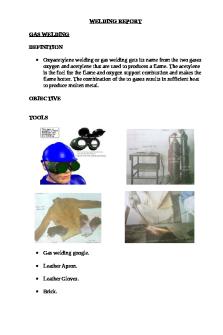Smaw welding electrode classification PDF

| Title | Smaw welding electrode classification |
|---|---|
| Course | Welding |
| Institution | Fanshawe College |
| Pages | 2 |
| File Size | 165.1 KB |
| File Type | |
| Total Downloads | 59 |
| Total Views | 139 |
Summary
This is a set of lecture notes of Shielded Metal Arc Welding (SMAW) taught by Professor Chris Hopper....
Description
WELDING ELECTRODE CLASSIFICATION SMAW MILD STEEL COATED ELECTRODES E7018-X
E 70 1 8 X
Indicates that this is an Electrode. Indicates tensile strength. Measured in thousands of pounds per square inch. Indicates welding position. Indicates the coating, penetration, and current type used. (See Classification Table below) Indicates that there are more requirements. (See Additional Requirements below)
WELDING POSITIONS 1 2 4
All positions (Flat, Horizontal, Vertical (up), Overhead) Flat, Horizontal Flat, Horizontal, Overhead, Vertical (down)
CLASSIFICATION TABLE Class
Electrode Coating
Penetration
Current Type
Exxx0 Exxx1 Exxx2 Exxx3 Exxx4 Exxx5 Exxx6 Exxx7 Exxx8 Exxx9
Cellulose, Sodium Cellulose, Potassium Rutile, Sodium Rutile, Potassium Rutile, Iron Powder Basic, Low Hydrogen, Sodium Basic, Low Hydrogen, Potassium Basic, Iron Powder, Iron Oxide Basic, Low Hydrogen, Iron Powder Basic, Iron Oxide, Rutile, Potassium
Deep Deep Medium Light Medium Medium Medium Medium Medium Medium
DCEP AC, DCEP AC, DCEN AC, DCEP, DCEN AC, DCEP, DCEN DCEP AC, DCEP AC, DCEN AC, DCEP AC, DCEP, DCEN
ADDITIONAL REQUIREMENTS Suffix
Additional Requirement
-1
Increased toughness (impact strength).
-M
Meets most military requirements - greater toughness, lower moisture content as received after exposure, diffusible hydrogen limits for weld metal.
-H4, -H8, -H16 Indicates the maximum diffusible hydrogen limit measured in millimeters per 100 grams (mL/100g). The 4, 8, and 16 indicates what the limit is. Example: -H4 = 4mL per 100 grams Pierre Dostie
WELDING ELECTRODE CLASSIFICATION SMAW LOW ALLOY STEEL COATED ELECTRODES SUFFIX TABLE Suffix -A1 -B1 -B2 -B2L -B3 -B3L -B4L -B5 -B6 -B8 -C1 -C1L -C2 -C2L -C3 -NM -D1 -D2 -D3 -W -G -M
Steel Alloy Type Carbon-Molybdenum Chromium-Molybdenum Chromium-Molybdenum Chromium-Molybdenum Chromium-Molybdenum Chromium-Molybdenum Chromium-Molybdenum Chromium-Molybdenum
Suffix Number Description 0.40 - 0.65 Mo 0.40 - 0.65 Cr 0.40 - 0.65 Mo 1.00 - 1.50 Cr 0.40 - 0.65 Mo Lower Carbon B2 2.00 - 2.50 Cr 0.90 - 1.20 Mo Lower Carbon B3 1.75 - 2.25 Cr 0.40 - 0.65 Mo 0.40 - 0.60 Cr 1.00 - 1.25 Mo 4.6 - 6.0 Cr 0.45 - 0.65 Mo 8.0 - 10.5 Cr 0.8 - 1.2 Mo 2.00 - 2.75 Ni Lower Carbon C1 3.00 - 3.75 Ni Lower Carbon C2 0.80 - 1.10 Ni 0.80 - 1.10 Ni 0.40 - 0.65 Mo 1.00 - 1.75 Mn 0.25 - 0.45 Mo 1.65 - 2.00 Mn 0.25 - 0.45 Mo 1.00 - 1.80 Mn 0.40 - 0.65 Mo Ni, Cr, Mo, Cu
Nickel Steel Nickel Steel Nickel Steel Nickel Steel Nickel Steel Nickel-Molybdenum Manganese-Molybdenum Manganese-Molybdenum Manganese-Molybdenum Weathering Steel No required chemistry Military grade May have more requirements
CHEMICAL SYMBOLS FOR THE ELEMENTS C Carbon Most effective hardening element in steel Mn Manganese Hardening element second to carbon Si Silicon Deoxidizer, moderate strengthener P Phosphorus Causes cracking if too high S Sulfur Aids in machining - Cracking problems like P Cr Chromium Hardness (low) - corrosion resistance (high) Ni Nickel Hardening element - better cold toughness Mo Molybdenum Hardenability - high temp tensile - creep strength B Boron Very small amounts increase hardness Cu Copper Corrosion resistance (low) - cracking (high) Al Aluminum Deoxidizer - improves mechanical properties Ti Titanium Removes: Oxygen, S, N, and C N Nitrogen Improves strength - lowers toughness Cb Columbium Hardness - Improves mechanical properties V Vanadium Hardness - Improves mechanical properties Pierre Dostie...
Similar Free PDFs

WELDING REPORT GAS WELDING
- 1 Pages

Pengelasan SMAW
- 26 Pages

WPS-SMAW - Práctica Soldadura
- 2 Pages

welding teknologi
- 425 Pages

BAB I LAS SMAW
- 59 Pages

Welding Inspection Handbook
- 29 Pages

Atomic Hydrogen Welding
- 1 Pages

P H with glass electrode
- 4 Pages

19. welding helmet
- 8 Pages

Instructional Welding Lesson Plans
- 34 Pages

MIG - MIG welding Report
- 12 Pages
Popular Institutions
- Tinajero National High School - Annex
- Politeknik Caltex Riau
- Yokohama City University
- SGT University
- University of Al-Qadisiyah
- Divine Word College of Vigan
- Techniek College Rotterdam
- Universidade de Santiago
- Universiti Teknologi MARA Cawangan Johor Kampus Pasir Gudang
- Poltekkes Kemenkes Yogyakarta
- Baguio City National High School
- Colegio san marcos
- preparatoria uno
- Centro de Bachillerato Tecnológico Industrial y de Servicios No. 107
- Dalian Maritime University
- Quang Trung Secondary School
- Colegio Tecnológico en Informática
- Corporación Regional de Educación Superior
- Grupo CEDVA
- Dar Al Uloom University
- Centro de Estudios Preuniversitarios de la Universidad Nacional de Ingeniería
- 上智大学
- Aakash International School, Nuna Majara
- San Felipe Neri Catholic School
- Kang Chiao International School - New Taipei City
- Misamis Occidental National High School
- Institución Educativa Escuela Normal Juan Ladrilleros
- Kolehiyo ng Pantukan
- Batanes State College
- Instituto Continental
- Sekolah Menengah Kejuruan Kesehatan Kaltara (Tarakan)
- Colegio de La Inmaculada Concepcion - Cebu




